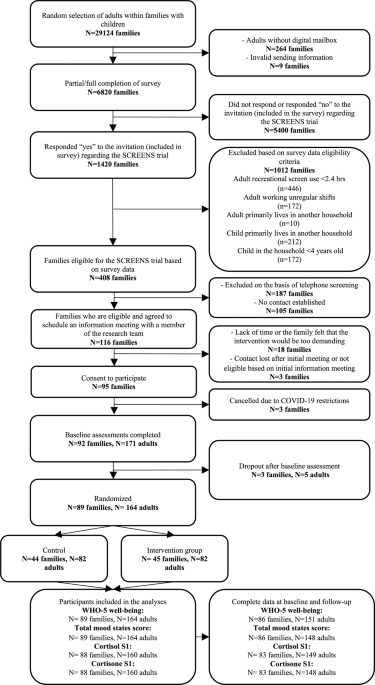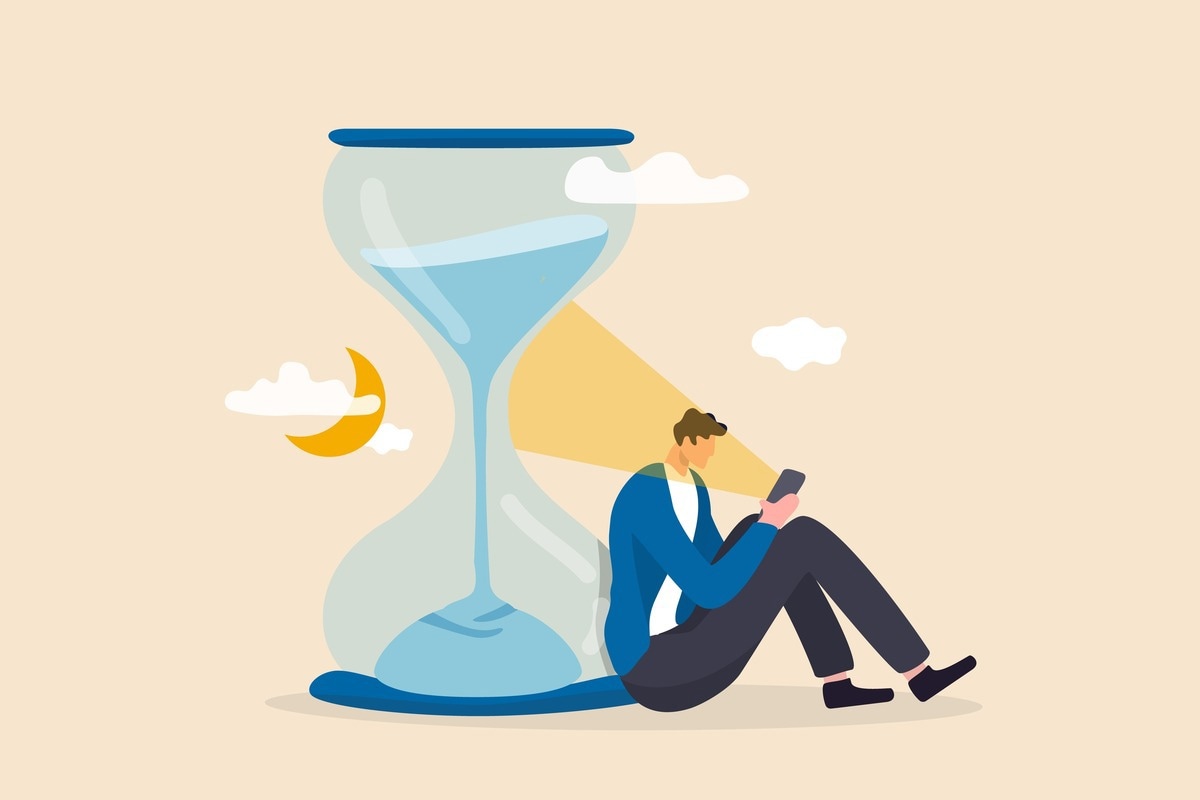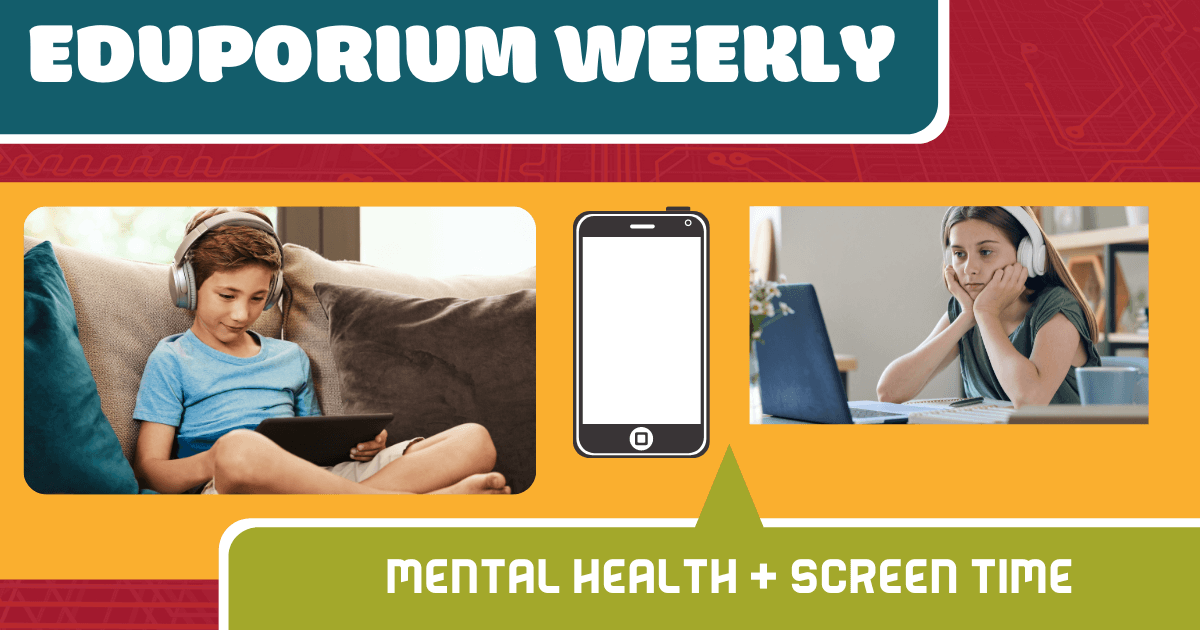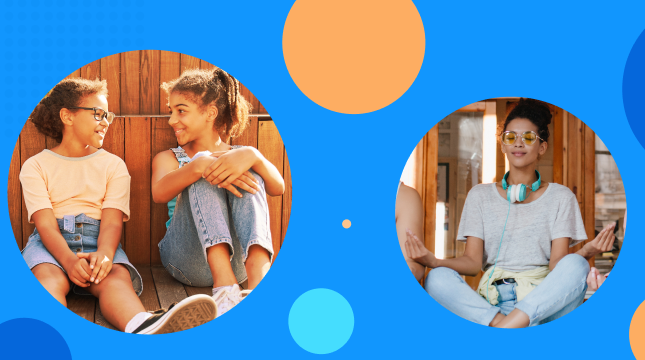Durchsuchen Sie die Webergebnisse zu dieser Domain.

A recent study finds that increased screen time is associated with higher levels of depression, anxiety, and attention issues among 9- and 10-year-olds.
Summary: A recent study finds that increased screen time is associated with higher levels of depression, anxiety, and attention issues among 9- and 10-year-olds.Spending more time on screens increases the likelihood that 9- and 10-year-olds will develop symptoms of mental illness, according to a study by UC San Francisco that is one of the first long-term looks at the problem. The study followed a diverse group of kids from around the country for two years and found that more screen time was associated with more severe symptoms of depression, anxiety, inattention and aggression. It appears Oct. 7 in BMC Public Health.Screen use appears to displace beneficial activities like exercise and in-person interactions, potentially amplifying mental health symptoms.Interestingly, the effect of screen time varied among racial groups, with white adolescents showing stronger associations between screen use and mental health symptoms than their Black or Asian peers.

Discover the positives and harms of social media, benefits of taking a digital break, and how a digital detox in 2025 can improve your mental health and well-being in the long run.
After all, mental and physical well-being remains our top priority, therefore, we must disconnect from this medium more often. As we step into 2025 it is a great opportunity to embrace a digital detox. By taking a break from digital devices this year, why not allow yourself to reset, refocus, and reconnect with the world around you? In this read let us look at its pros and cons and how to do this activity as often as possible. Also Read: Therapy For Mental Health: The Most Common Psychological Conditions That Might Need Immediate HelpDigital detox refers to taking a break from screens like mobile phones, computers, and social media to improve mental and physical health, aid restful sleep, and boost creativity by limiting screen time. It also encourages us to engage in offline activities like reading, exercising, and spending quality time with our loved ones. A regular digital detox can enhance overall well-being and create a healthier balance between technology and real-life experiences.To Augment Your Mental Health And Sharpen Memory, Buy From Our Wide Range Of Nutritional Supplements · A perfect time to start something that will let you reclaim time spent scrolling mindlessly, as you shift your attention to tasks that truly matter, a small Digi-detox promise in 2025 is an ideal way to sharpen your focus, enhance productivity, improve body posture, and encourage physical activity. Take a look at some well-known holistic incentives for staying away from screens:Also Read: Neuro Radiance: Blending Beauty Rituals With Mental Wellness. 7 Ideas To Get Glowing From Within · A valuable tool for achieving greater balance, health, and fulfillment in the months ahead, when planning to detox from technology, begin with short breaks, gradually increasing screen-free time to avoid feeling overwhelmed, and maintain consistency.
: In a world dominated by screens, unravel the impact on mental health. From social media challenges to the blue-light dilemma, this blog explores the nuances of screen time. Dive into strategies for a healthy digital diet and mindful tech practices and seek support when needed.
In the bustling landscape of the digital age, where screens have become an integral part of our daily lives, the impact on mental health cannot be overlooked. As we seamlessly transition between devices, from smartphones to laptops, the lines between the virtual and the real blur. While technology has undoubtedly brought convenience and connectivity, understanding the delicate balance between screen time and mental well-being is crucial in this digital era.The constant barrage of information, social media pressures, and the sedentary nature of screen-based activities contribute to a complex web of challenges for mental well-being. ... The allure of social media often comes with a cost. The constant comparison, fear of missing out (FOMO), and pressure to present a curated version of life contribute to increased stress levels. Navigating the digital realm requires mindfulness to avoid the pitfalls of social media's impact on mental health.If screen time begins to significantly impact your mental health, don't hesitate to seek support. Professional help, such as counseling or therapy, can provide valuable strategies for navigating the digital landscape while safeguarding mental well-being.By fostering awareness, setting boundaries, and incorporating mindful practices, we can navigate the digital landscape with greater resilience and well-being. The key lies in embracing the positive aspects of technology while actively mitigating its potential negative impact on our mental health. As we strive for a balanced digital diet, let's ensure that screens enhance, rather than detract from, our overall wellness in this rapidly evolving digital era.


In today’s interconnected world, ... mental and physical well-being. For Canadians striving to prevent chronic diseases and boost mental health, it’s essential to recognize that our digital habits directly impact our health. Screen time, internet use, and social media ...
In today’s interconnected world, digital wellness is emerging as a pivotal component of health, shaping how we interact with technology while maintaining mental and physical well-being. For Canadians striving to prevent chronic diseases and boost mental health, it’s essential to recognize that our digital habits directly impact our health. Screen time, internet use, and social media engagement can lead to stress, sleep disturbances, and reduced physical activity.Embracing digital wellness encourages balanced tech usage through mindful practices that prioritize screen time management, healthy online interactions, and regular digital detoxes. By adopting these strategies, individuals can support their mental clarity, enhance their fitness routines, and achieve a healthier lifestyle.Digital wellness is guided by several core principles that focus on achieving a balanced and healthy relationship with technology. Firstly, it emphasizes mindful usage, encouraging individuals to be aware of how and why they use digital devices, reducing unnecessary screen time, and fostering meaningful interactions. Additionally, digital wellness promotes setting boundaries, such as designating tech-free zones and times, to protect personal and mental space.By adhering to these principles, Canadians can enhance their overall health and well-being in today’s tech-centric world. Screen time can influence our psychological wellbeing, both positively and negatively. On the positive side, digital devices can help us stay connected with friends and family, provide access to valuable information, and even offer apps that boost your mental health.

Spending more time on screens increases the likelihood that 9- and 10-year-olds will develop symptoms of mental illness, according to a study by UC San Francisco that is one of the first long-term looks at the problem. The study followed a diverse group of kids from around the country for two ...
Spending more time on screens increases the likelihood that 9- and 10-year-olds will develop symptoms of mental illness, according to a study by UC San Francisco that is one of the first long-term looks at the problem. The study followed a diverse group of kids from around the country for two years and found that more screen time was associated with more severe symptoms of depression, anxiety, inattention and aggression. It appears Oct. 7 in BMC Public Health.Their expertise covers virtually all pediatric conditions, including cancer, heart disease, neurological disorders, pulmonology, diabetes and endocrinology, as well as the care of critically ill newborns. The two campuses in San Francisco and Oakland are known worldwide for basic and clinical research and are at the forefront of translating research into interventions for treating and preventing pediatric disease. They are part of UCSF Health, whose adult hospital ranks among the top 10 medical centers nationwide and serves as the teaching hospital for the University of California, San Francisco, a national leader in biomedical research and graduate-level health/sciences education.Concern about adolescents' mental health has grown in recent years, as their screen use has surged. Adolescents are 50% more likely to experience a major depressive episode and 30% more likely to commit suicide today than they were 20 years ago. The average time spent each day on screens for non-educational reasons is now 5 1/2 hours for tweens and 8 1/2 hours for teens.

Find employee wellness software that combats burnout, boosts engagement, and fosters a healthy work culture. Read our expert reviews to find the best solution for your team today!
According to a Mental Health America study, 9/10 employees reported that workplace stress affects their mental health, leading to reduced efficiency and service delivery. By promoting and incentivizing healthy behaviors within your workforce, you’ll set a better example and be seen as a more proactive employer in the eyes of your employees. When employees feel they are genuinely cared for, they’ll be more motivated to go the extra mile for their employer too. Yes, wellness programs work and can help employees overcome stress and anxiety.These are anytime, anywhere tools that empower every employee to take control of their mental health. headversity offers pricing details upon request and offers a free demo. ... Pulse consolidates employee benefits in a centralized location for easier access. Pulse is a digital wellbeing platform that combines wellbeing, condition management, and benefits in a unified location.Employee wellness software is a digital tool that helps employees monitor and track their own physical and mental health. They include tools to monitor health metrics like physical activity, sleep, and nutrition, as well as additional resources to support mental health challenges such as stress, anxiety, or depression.For more advanced wellness apps, this type of monitoring also covers biometric screening for key details like heart rate and blood pressure. Personalized Wellness Plans: Tailored wellness programs give employees the flexibility to work toward personal health goals, which helps them engage more deeply and feel supported in their unique wellness journeys. Mental Health Resources: Access to mental health tools, like therapy sessions or meditation guides, is essential for managing stress and building resilience, which contributes to a more balanced and motivated team.
Studies have linked higher digital screen use with poorer mental health. However, there is limited experimental evidence to suggest a causal relationship. In this trial, we aimed to investigate the effects of limiting recreational digital screen use on mental well-being, mood, and biomarkers ...
Studies have linked higher digital screen use with poorer mental health. However, there is limited experimental evidence to suggest a causal relationship. In this trial, we aimed to investigate the effects of limiting recreational digital screen use on mental well-being, mood, and biomarkers of stress in healthy young and middle-aged adults.Finally, findings may not be generalizable beyond healthy adults who live in households with children. Collectively, our study provides experimental evidence that limiting recreational digital screen use positively affects mental well-being and mood in adults. Our findings highlight the importance of awareness of the amount of time adults spend using recreational digital screen media devices.npj Mental Health Research - Effects of limiting digital screen use on well-being, mood, and biomarkers of stress in adultsParticipants had to provide one of the following answers: All of the time (5), most of the time (4), more than half of the time (3), less than half of the time (2), some of the time (1), at no time (0). The final score was calculated for each adult by adding the scores from the five items and multiplying the raw sum by 434. Higher scores correspond to better mental well-being. Overall mood states were assessed using the Profile of Mood States questionnaire, which is a validated and widely used scale to assess mood states in healthy populations47,48.

Whether for work, social interactions, ... in digital tools. I completely understand, especially with my business heavily reliant on social media! While the benefits of technology are undeniable, excessive screen time can harm our mental health, emotional health, and physical well-being. Finding the right balance between screen use and self-care practices ...
Whether for work, social interactions, or entertainment, it’s easy to spend hours each day immersed in digital tools. I completely understand, especially with my business heavily reliant on social media! While the benefits of technology are undeniable, excessive screen time can harm our mental health, emotional health, and physical well-being. Finding the right balance between screen use and self-care practices is key to maintaining a healthy balance in life.Remember, self-care in the digital era is about finding the right balance between the convenience of technology and the need for real-world connection and holistic well-being. Embrace a balanced approach to tech use, where screens enhance your personal growth without overshadowing the importance of mental, physical, and emotional health.Additionally, use these breaks to stretch, hydrate, or take a short walk, .supporting both your physical and mental health · Balance screen time with offline hobbies and activities that bring you joy and relaxation. Whether it’s reading a book, cooking a meal, gardening, or practicing a creative pursuit, these activities provide a healthy contrast to digital engagement and nourish your soul. Intuitive eating encourages listening to your body’s signals and responding with care.Having worked with hundreds of clients to build a healthier relationship with food, stop dieting, and achieve sustainable weight loss (including maintaining my own 10-pound loss), I’ve seen firsthand how digital consumption pulls us away from being present with our bodies. Scrolling through social media, we’re bombarded with others’ needs, losing sight of our own, and often turning to food as an emotional crutch. Setting clear boundaries and prioritizing our mental well-being is the first step to reclaiming control. Before diving into strategies for managing screen time, it’s important to recognize its potential impact on your health:

Screen time refers to the time a person spends looking at a screen on a device such as a television, smartphone, computer, or game console. Read more here about the effect of screen time on mental health.


Mental health apps can help you overcome everyday hurdles such as stress, improve your sleep and mental focus, and access online therapy from your phone or tablet. Read on to learn about the best mental health apps and how they compare.
The best mental health apps are affordable, user-friendly, and well-designed, with few technical glitches—allowing you to improve your emotional well-being and overall wellness in enjoyable, accessible ways. High-quality therapy apps remove some of the usual barriers to mental health care, while mindfulness apps can help you achieve better focus and productivity.Mental health apps, like Real app, can vary greatly in terms of function, design, purpose, and features. There are six main types of mental health apps, each aimed at helping in a particular area of mental wellness. These areas include: ... Some mental health apps also offer online mental health care (such as talk therapy or psychiatric care) directly.For parents and caregivers, the app includes free resources for teaching your child problem-solving skills and self-soothing strategies. There are additional materials available on the app’s free companion website, so you can continue to help your child on their mental wellness journey.Some simple mental health apps, such as sobriety counter apps and apps that teach deep breathing techniques, are free to use. However, many apps offer a free basic version as well as a premium version with many additional features. A monthly subscription to a premium version of a mental health app often ranges from about $9 to $15 per month.
While many other pandemic-induced ... of skyrocketing screen time have also caught up with many students. As we continue to hone in on student mental health concerns, it’s important that parents and educators work together to help keep digital wellbeing in focus...
While many other pandemic-induced issues, like equity, isolation, relationships, and SEL have been some of the key focal areas, the effects of skyrocketing screen time have also caught up with many students. As we continue to hone in on student mental health concerns, it’s important that parents and educators work together to help keep digital wellbeing in focus.Brought on by our reliance on technology for work, convenience, and learning, the Google team started the Digital Wellbeing campaign. Essentially, the movement helps raise awareness when it comes to the amount of time we spend using technology, looking at screens each day, and the resulting mental health effects it's had on children.If we’re constantly receiving notifications, it's very distracting—especially for those trying to focus on staying away from screens. One solution is to pause notifications until a predetermined time (say 12 PM) so that they’re not constantly coming in. This is something that’s beneficial among both teachers and students and, hopefully, helps keep everyone's mental health strong. Eduporium Weekly | The Digital Divide And Learning · Digital wellness is so important all the time but it certainly has a different feel as we continue navigating the pandemic era.Devices can provide indications of when to scale back screen time, how eye strain could perpetuate, when to increase physical activity, and how to achieve better sleep. All those factors go into sustaining mental health and pretty much all weren't on the radar a few years ago. As we learn more about the impacts that constant technology usage has, however, it's become much more important. Also, digital wellness means different things for teachers than for students.


Mental health apps are the perfect supplement to your wellness journey. The best mental health apps can help you boost your mood, lower anxiety, and more.
This is unique to the mental health app space. You have access to a peer community that offers support and empowerment. ... Shine offers a free app version, though you will not have access to all the features offered. The price is about average when compared to the other options on the list. Standout features Targets the needs and struggles of people of color, meditations, self-care courses led by experts, monthly virtual workshops, daily wellness check-ins, motivational messagesThe unique experiences of people of color are often excluded from traditional mental health resources. The wellness app industry is traditionally not inclusive and mainly focuses on experiences that white people encounter. Only one in three Black Americans get the mental health care they need.It's specially designed to target the needs and struggles of people of color, making mental health resources more accessible and inclusive. Shine offers meditations, self-care courses led by experts and monthly virtual workshops. You are also prompted to add a wellness check-in each day and are greeted with motivational messages.You can track sleep, nutrition, exercise and more during your wellness journey. Moodfit uses tools and sessions that help you assess your feelings, recognize negative thinking and change it. The Moodfit app has pretty standard navigation. The "notices" tab at the bottom is what I would consider the educational section. There is a lot of good information available, like how your thoughts influence your behavior and feelings, but you will have to take the time to actually read it. Other mental health apps have a more interactive experience with imagery, videos and readouts.
In our increasingly digital age, screens have become an inescapable part of daily life for most people. From checking smartphones first thing in the morning to hours spent in front of computer screens at work or school, not to mention evenings of mindless scrolling on social media or binge-watching ...
In our increasingly digital age, screens have become an inescapable part of daily life for most people. From checking smartphones first thing in the morning to hours spent in front of computer screens at work or school, not to mention evenings of mindless scrolling on social media or binge-watching shows, we are constantly bombarded with digital stimuli.From checking smartphones first thing in the morning to hours spent in front of computer screens at work or school, not to mention evenings of mindless scrolling on social media or binge-watching shows, we are constantly bombarded with digital stimuli. While technology has brought undeniable conveniences and connectivity, excessive screen time can have serious negative impacts on our overall mental well-being and health.Our digital lives can have significant consequences on our mental health. From heightened stress and anxiety caused by constant notifications and social media overload, to feelings of loneliness and depression, as well as impaired focus and disrupted sleep patterns, it's essential to understand these risks to better safeguard our well-being. ... While completely eliminating screen time is unrealistic in today's world, there are strategies we can employ to create a healthier balance and promote digital wellness:Mental health impacts like anxiety, depression, etc. Implementing these digital wellness strategies can go a long way, but having the right tools makes the journey much easier. LifeAt.io is a revolutionary platform designed to help cultivate balance and mindfulness in our digital age.
Call 1-800-950-NAMI (6264) M–F, 7 a.m.–3 p.m. PT for free mental health info, referrals and support. ... Do you pick up your phone to check the news and find yourself getting lost down the virtual rabbit hole of comments on a post about a subject you don’t even care about?
Call 1-800-950-NAMI (6264) M–F, 7 a.m.–3 p.m. PT for free mental health info, referrals and support. ... Do you pick up your phone to check the news and find yourself getting lost down the virtual rabbit hole of comments on a post about a subject you don’t even care about? Are you stressed out from doomscrolling? Blurry-eyed with a kink in your neck every night from staring at screens all day long?To maintain balance and peace of mind, I’ve learned about the need to set screen-time limits and disconnect often. It comes down to boundaries for me, with time and space. Here are some specific tips that help me manage my screen time to maintain good mental health.Our focus is pulled in multiple directions during the day and the options available on our devices can make us more distracted. Watching TV while also scrolling on your phone or tablet or clicking around on your computer means your attention is divided. Ask yourself, is that time well spent? Consider one screen at a time, one activity at a time.Next time you reach out to lazily consume an endless stream of photos that blur together, pause and change course. Call a loved one, dance to a favorite song, or choose to spend time on one of the self-care activities that make you feel good. Reducing your screen time can be easier if you find satisfaction with other, more fulfilling activities.


The research, a secondary analysis ... well-being. Participants showed a reduction in behavioral difficulties, particularly internalizing symptoms like emotional and peer-related issues, along with enhanced prosocial behaviors. Concerns about the potential negative effects of digital screen use on young people’s mental health have grown ...
The research, a secondary analysis of the SCREENS randomized clinical trial, found that reducing leisure-time screen media use led to notable improvements in psychological well-being. Participants showed a reduction in behavioral difficulties, particularly internalizing symptoms like emotional and peer-related issues, along with enhanced prosocial behaviors. Concerns about the potential negative effects of digital screen use on young people’s mental health have grown in recent years.Reducing leisure screen time for two weeks improved children’s mental health by decreasing emotional and peer-related difficulties while boosting positive social behaviors, highlighting the benefits of taking short breaks from screen media use.“This is a good step in understanding how screen time is related to child and adolescent mental health,” Hadfield added. “However, we should be careful about over-interpreting a relatively small study as considerably more experimental research would be needed to understand how, to what extent, and for whom screen time impacts mental health.Previous studies have found small but significant associations between high screen time and poor mental health. However, these studies couldn’t establish causation due to their reliance on self-reported data and the lack of experimental control. “We were interested in the link between screen media use and mental health because the observational studies conducted remained inconclusive.

In today’s digital age, taking breaks from screens is essential for maintaining mental health. Many individuals find themselves constantly connected to their devices for both professional and personal use. While technology offers undeniable convenience and connectivity, the impact of excessive screen time on mental and physical health cannot be overlooked. Understanding the importance of regular screen time breaks can lead to improved mental well...
In today’s digital age, taking breaks from screens is essential for maintaining mental health. Many individuals find themselves constantly connected to their devices for both professional and personal use. While technology offers undeniable convenience and connectivity, the impact of excessive screen time on mental and physical health cannot be overlooked. Understanding the importance of regular screen time breaks can lead to improved mental well-being, greater productivity, and a more balanced life.It also allows for the exploration of new hobbies and activities that promote well-being without the constant intrusion of digital screens. Achieving a balance in digital engagement is key to maintaining mental health. Setting personal limits on screen time, prioritizing necessary tasks, and ensuring breaks can help maintain focus and prevent digital burnout.This balanced approach supports a thriving mental state, which translates into improved overall well-being. In children and adolescents, studies have shown that higher screen time lowers curiosity, self-control, and emotional stability, all of which affect their well-being and even their ability to form relationships, sometimes even necessitating adolescent therapy to address the issues. Creating and sustaining healthier digital habits requires commitment and mindfulness.In today's digital age, taking breaks from screens is essential for maintaining mental health. Many individuals find themselves constantly connected to their
Learn how to reduce excessive screen time for better health. Excessive screen time can have significant physical impacts on individuals of all ages, contributing to a host of health concerns.
Achieving digital wellness doesn’t mean completely unplugging from the online world. Think of it more as finding the sweet spot between screen time and mental health. When we recognize how too much screen time can affect us, and try some helpful detox tricks, we can take charge of our lives.Excessive screen time doesn’t just take a toll on our physical health; it can also significantly affect our mental well-being.No matter how we use our devices, most of us spend more time than not eyes-deep in our screens—often to the point of sacrificing healthier habits. In this comprehensive guide, we’ll delve into the impacts of too much screen time, how it can detrimentally affect our well-being and productivity, and, most importantly, offer strategies for achieving digital wellness through a balanced approach to technology.As you embark on your digital wellness journey, we’re here to provide the tools you need to combat screen addiction. At Freedom, we offer a comprehensive solution, enabling users to regain control over their digital habits and prioritize their well-being. Sound good? Start your free trial today and take the first step towards a healthier relationship with technology.

Although digital devices offer convenience it is important that we find the right balance between using technology and personal well-being.
This blog looks at teaching digital wellness, exploring why it is important, and how schools and parents can work together to impart these important skills upon students. Join us in celebrating and embracing Safer Internet Day’s mission of creating a healthier, more secure online world for all and coming together for a better internet. First, we need to understand the impact excessive screen time can have on our physical and mental health.Prolonged use of screens has been linked to eye strain, sleep deprivation, and even adverse effects on mental well-being. There is substantial evidence suggesting these correlations with direct associations between excessive screen time with mental health concerns, such as anxiety, depression, and disturbances in sleep patterns.Although these functionalities offer convenience for many it is also important that we find the right balance between using technology and personal well-being. “Every year, Safer Internet Day serves as a timely reminder to reflect on our digital habits and adopt practices that promote a healthier digital lifestyle.”Let’s work together for a better internet by consistently reflecting on our digital habits, we will all be better equipped to make informed decisions and maintain a healthier relationship with the seemingly ever-increasing role of technology in our daily lives. On this Safer Internet Day, let’s prioritise our digital well-being by striking a balance between screen time and personal health.


Author Carlos Whittaker spent seven weeks without his phone in 2022. He discovered many things about himself and about the world around him that he had been missing which are detailed in his new book.
LIMIT OF 3 HOURS OF WEEKLY SCREEN TIME FOR KIDS HAS ‘POSITIVE EFFECT’ ON BEHAVIOR, MENTAL HEALTH: STUDY · Whittaker almost quit the experiment at the very beginning. · "When you can't get out of your head by picking up your phone and scrolling TikTok or X or whatever it is, and you're stuck in your own thoughts – that's something we're not used to, and I definitely wasn't used to it," he said. · This sudden digital detox led to "four days of panic," he said, as he experienced "panic attacks, night sweats, heart palpitations [and] jitters."Christine Rousselle is a lifestyle reporter with Fox News Digital. Stay up-to-date on the biggest health and wellness news with our weekly recap.Carlos Whittaker, pictured, lived without screens for seven weeks in 2022 in an experience he described as life-changing. (Carlos Whittaker) "That's exactly what I did," Whittaker told Fox News Digital in a Zoom interview.This book is about how beautiful it is on the other side of the phone," he told Fox News Digital. · "This book isn't about how bad phones are. This book is about how beautiful it is on the other side of the phone." "Instead of setting up all these rules and restrictions for my screen time, once I fell in love with wondering, with noticing, with savoring, with 90-minute meals – with all of these things I was doing without my phone, I just picked up my phone less."
Previous research on associations between screen time and psychological well-being among children and adolescents has been conflicting, leading some researchers to question the limits on screen time suggested by physician organizations. We examined a ...
The current research aims to examine associations between screen time and a diverse array of measures of psychological well-being (including emotional stability, relationships with caregivers, self-control, diagnoses of mood disorders, and treatment of mental health issues) among a large population-based survey of the caregivers of children and adolescents ages 2 to 17 collected in 2016 in the U.S.The survey was administered either online or on paper, with an oversampling of children with special health care needs. The response rate was 40.7%. Data are publicly available on the NSCH website. We excluded children and adolescents with at least one of 8 major conditions that might affect their day-to-day functioning: Autism, blindness, cerebral palsy, deafness, Down Syndrome, developmental delay, epilepsy, or intellectual disability (mental retardation), as these were related to both well-being and to screen time.Caregivers also described high users as more difficult to care for and as lower in self-control. Among adolescents, high (vs. low) users were also twice as likely to have received diagnoses of depression or anxiety or needed treatment for mental or behavioral health conditions. Moderate users were also significantly more likely than low users of screens to be low in well-being and, among 14- to 17-year-olds, to have been diagnosed with depression or anxiety or need mental health treatment.For example, an assessment of screen time may help providers identify children and adolescents at higher risk for mental health issues and broach the topic of the possible role of screen time in mental health among these individuals. These data are limited by several factors. First, screen time was reported by caregivers and not the children or adolescents themselves. This likely resulted in underestimates of screen time and may have unknown interactions with reports of well-being.











